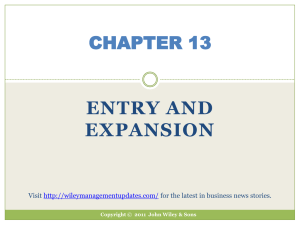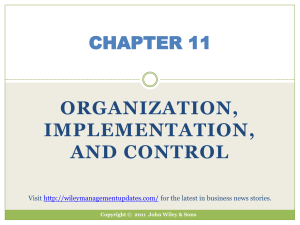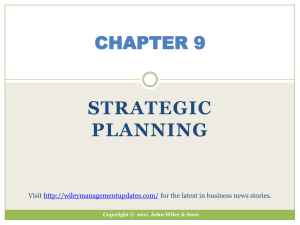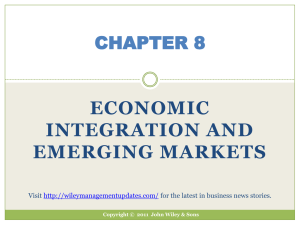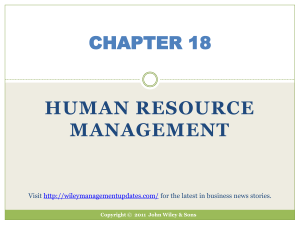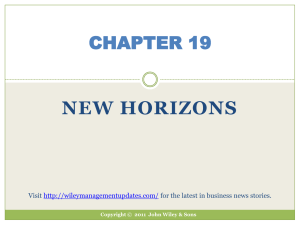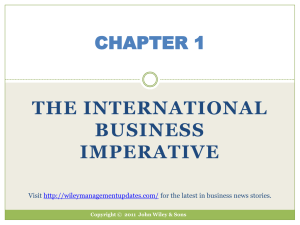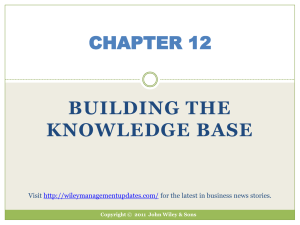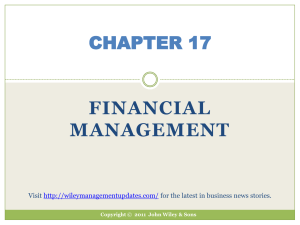Chapter 3
advertisement
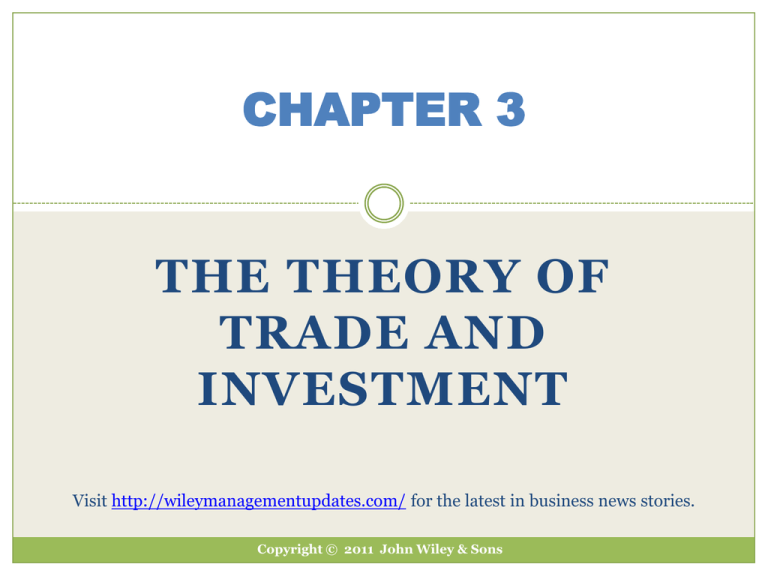
CHAPTER 3 THE THEORY OF TRADE AND INVESTMENT Visit http://wileymanagementupdates.com/ for the latest in business news stories. Copyright © 2011 John Wiley & Sons Chapter 3 Learning Objectives Chapter 3 1. To understand the traditional arguments of how and why international trade improves the welfare of all countries 2. To review the history and compare the implications of trade theory from the original work of Adam Smith to the contemporary theories of Michael Porter 3. To examine the criticisms of classical trade theory and examine alternative viewpoints of which business and economic forces determine trade patterns between countries 4. To explore the similarities and distinctions between international trade and international investment 5. To evaluate the trade theories of Paul Krugman and Michael Porter and their relationship to business and government’s approaches to trade policy 6. To understand the theory of international investment and how it relates to firms and buyers 2 Czinkota: International Business, 8e Foundation Questions Why do countries trade? Do countries trade or do firms trade? Do the elements that make a firm, industry, or country competitive change with time and circumstance? Once identified, can sources of competitiveness be manipulated or managed by firms or governments to the benefit of traders? Chapter 3 3 Czinkota: International Business, 8e McDonald’s Global Reach International Business makes good business sense for McDonalds corporation. Although the United States was the first successful market for the company, it now does business in dozens of countries world wide. In fact, only 28 percent of total revenue generated in 2009 came from the U.S. market. See the geographic breakdown of revenue below for details: • • • • U.S.: 28% Europe: 43% Asia/Pacific/Middle east/africa (APMEA): 24% Other and Corporate: 5% Source: McDonald’s 2009 Annual Report: http://www.aboutmcdonalds.com/mcd Chapter 3 4 Czinkota: International Business, 8e The Age of Mercantilism Three major events have led to the evolution of trade in the form we see today: The collapse of feudal society State of autarky where only basic needs were met Emergence of a mercantilist philosophy Focus was on increasing a nation’s power Strength in gold and silver Life cycle of the colonial systems of the European nationstates Industrialization and mass production Lowering prices and increasing supplies Chapter 3 5 Czinkota: International Business, 8e The Evolution of Trade Theory The Theory of Absolute Advantage Adam Smith, 1776 The Theory of Comparative Advantage David Ricardo, 1819 The Theory of Factor Proportions Eli Heckscher and Bertil Ohlin, early 20th Century The Leontief Paradox Wassily Leontief, 1950 Overlapping Product Ranges Theory Staffan Burenstam Linder, 1960s Product Cycle Theory Raymond Vernon, 1966 Imperfect Markets/Strategic Trade Paul Krugman, 1980s The Competitive Advantage of Nations Michael Porter, 1990s Chapter 3 6 Czinkota: International Business, 8e Absolute Advantage & Comparative Advantage Absolute Advantage Theory Comparative Advantage Theory Adam Smith, The Wealth of David Ricardo, The Principles Nations, 1776 of Political Economy and Taxation, 1819 Division of labor in the production process Involves producing a good Each country should more cheaply relative to other goods in other countries specialize in a product for which it is uniquely suited Each country possesses Countries could produce more and engage in trade for products not produced at home Chapter 3 comparative advantage in something, and both countries would benefit from trade 7 Czinkota: International Business, 8e Classical Trade Theory Concluding Points: Division of Labor Comparative Advantage Chapter 3 Gains from Trade 8 Czinkota: International Business, 8e Factor Proportions Trade Theory Developed by Heckscher, expanded by Ohlin Factor prices determine cost differences Factors of production include labor and capital Technology determines the way factors combine to form a good Prices are determined by the endowments of labor and capital Country’s endowment determines the relative costs of labor and capital Leontief Paradox Leontief used input-output analysis to determine the relative amounts of labor and capital in a good Finding: the U.S. was actually exporting products that were relatively labor intensive, contradicting the Factor Proportions Theory Chapter 3 9 Czinkota: International Business, 8e Focus on Politics: When the Numbers Don’t Add Up International trade statistics between countries often do not match. One reason for the discrepancy is geographic coverage definitions. For instance, the U.S. considers Puerto Rico and the U.S. Virgin Islands as part of the United States, and Mexico regards them as separate countries. Another problem is partner country attribution w here forms allow for the reporting of a single country of origin. The p r o d u c t m a y h a v e b e e n m a d e i n m o r e t h a n o n e c o u n t r y. Chapter 3 10 Czinkota: International Business, 8e Linder’s Overlapping Product Ranges Theory Linder’s work focused on the preferences of consumers rather than production or supply Trade in manufactured goods was dictated by product demands across countries The type, complexity, and diversity of product demands of a country increase as the country’s income increases Directors of firms are more knowledgeable about the domestic market than about foreign markets The overlapping product ranges described by Linder were later termed market segments Chapter 3 11 Czinkota: International Business, 8e Focus on Politics: The U.S. Trade Deficit Fix - Global Financial Crisis One of the fastest ways to shrink trade deficits is economic recession. The global financial crisis that began in 2007 was based largely in the United States, and it was the factor that forced Americans to stop spending. H o w e v e r, t h i s a l s o p u t a h a l t t o i n t e r n a t i o n a l t r a d e a n d brought a globalized world economy to a halt. In 2009, it was still not clear whether a permanent change in spending and saving w ould result. Chapter 3 12 Czinkota: International Business, 8e Product Cycle Theory Developed by Raymond Vernon in 1966 Focused on the product, not its factor proportions Information, knowledge, costs, and power all have a role Vernon added two premises to the factor-cost emphasis of existing theory: Technical innovations predominantly occur in highly industrialized capital intensive countries Technical innovations go through three stages of maturation A limitation of this theory is that it does not apply to all industries Technology industries are the most applicable Chapter 3 13 Czinkota: International Business, 8e Stages of the Product Cycle Stage I: New Product • Nonstandardized product • Requires high degree of flexibility Stage II: Maturing Product • Increasingly standardized • Need for flexibility declines • High costs to the firm • Demand for skilled labor declines • Consumers buy regardless of price • Variations develop Chapter 3 Stage III: Standardized Product • Completely standardized • Thin profit margins • Fierce competition • Price an increasing concern 14 Czinkota. 2010. International Business. 8e Apple’s Mac Growth Potential Overseas Despite being overshadowed by Apple’s own iPhone and the iPad, market consultants believe that Apple's Mac business has plenty of revenue growth left to exploit. Apple has the opportunity to add an incremental $5 to $7 billion to its revenue stream by increasing its international market share in what they call the midrange PC target zone (priced between $700 - $1,119). Most of Apple’s growth has been in the high end of the U.S. market. Apple’s U.S. share of the mid-range PC target zone in 2009 was 22%. However, it currently has only a 2% share of the mid-range market overseas. Source: Fortune.com -- http://tech.fortune.cnn.com/2010/05/27/how-the-mac-picks-up-an-easy-5-7-billion/ Chapter 3 15 Czinkota: International Business, 8e Economies of Scale Paul Krugman focused on cost of production and how cost and price drive international trade Internal Economies of Scale The larger the firm the greater the scale benefits, and the lower the cost per unit A firm could then monopolize an industry and create an imperfect market External Economies of Scale A country can dominate world markets if its industry can gain economies of scale The industry can then maintain its dominance in the world market Chapter 3 16 Czinkota: International Business, 8e Strategic Trade Price Government can impose tariffs to offset the monopolistic power of a foreign firm Cost Governments protect the market from foreign competition to allow domestic firms to grow and gain economies of scale Repetition Government protection until the firm learns through repetition how to produce the product more efficiently Government protects and nourishes an Externalities industry where it believes future growth can be achieved Chapter 3 17 Czinkota: International Business, 8e The Competitive Advantage of Nations According to Michael Porter, a nation’s competitiveness depends on the capacity of its industry to innovate and upgrade Four major components that drive and sustain competitiveness: Factor Conditions Chapter 3 Related and Supporting Industries Demand Conditions 18 Firm Strategy, Structure, and Rivalry Czinkota: International Business, 8e The Foreign Direct Investment Decision Exploit competitive advantage in new foreign markets or in the domestic market? Produce at home and export or produce abroad? License production or try to control assets abroad? Use a joint venture or a wholly owned affiliate? Acquire an existing foreign enterprise or build “from the ground up” (greenfield investment)? Chapter 3 19 Czinkota: International Business, 8e The Theory of Foreign Direct Investment What motivates a firm to go beyond exporting or licensing? Firms as seekers – A firm that expands across borders seeks sources of profit or opportunity: Seeking resources Seeking factor advantages (such as low cost labor) Seeking knowledge Seeking security Seeking markets Chapter 3 20 Czinkota: International Business, 8e France’s Carrefour Bets on India 95 percent of retail shopping in India occurs in mom-and-pop stores called kirana shops. Organized outlets (supermarkets, hypermarkets and department stores) account for just 5 percent of the $450 billion retail market. Thanks to robust economic growth and a fast-expanding middle class, big retailers are starting to cash in on an emerging retail market in India. The latest retail giant to arrive is Carrefour, which will open its first outlet in Delhi in July 2010, with more shops scheduled for other cities later in the year. The French firm follows Wal-Mart, the world’s biggest retailer, which last year opened its doors in Amritsar, India. Carrefour has waited nearly a decade, deterred by restrictive laws that let foreigners invest a 51 percent stake in only single-brand stores. Source: The Economist -- http://www.economist.com/node/16168260 Chapter3 Czinkota: International Business, 8e The Theory of Foreign Direct Investment Firms as Exploiters or Imperfections Imperfections in access (to avoid tariffs) Imperfections in factor mobility (using the mobility of capital to take advantage of the immobility of labor) Imperfections in management Firms as Internalizers By establishing their own multinational operations, firms can internalize the production Confidential information is kept at the core of the firm’s operations Chapter 3 22 Czinkota: International Business, 8e Focus on Politics: Bridging the Red Sea Ta r e k b i n L a d e n i s l e a d i n g a p r o j e c t t o b u i l d a 2 9 k i l o m e t e r - l o n g b r i d g e f r o m D j i b o u t i t o Ye m e n , t r a v e r s i n g the Red Sea. The bridge w ould link the Arabian Peninsula and Africa, a n d w o u l d p r o v i d e a b a s e f o r h i g h w a y, r a i l w a y, a n d pipeline conduits. It would connect drought -stricken Djibouti w ith valuable resources. B e c a u s e D j i b o u t i a n d i t s n o r t h e r n n e i g h b o r, E r i t r e a h a v e a long-standing border dispute, this plan may not come to fruition. Chapter 3 23 Czinkota: International Business, 8e

